Schefflera Amate: A Beautiful “Jurassic Park” Houseplant
If you want an easy, fast-growing plant that really makes a statement, then look no further. Schefflera Amate’s glossy, rich green leaves and impressive size are what make it so popular. Here’s how to care for this bold and beautiful houseplant known simply as Amate, or Umbrella Tree.
When I was an interior plantscaper many years ago, the predecessor (or parent) of this plant was known as Tupidanthus calyptratus, or in common speak, Umbrella Tree and/or Mallet Flower.
These days its name is Schefflera pueckleri and you can find it sold in the exterior trade along with the Schefflera actinophylla. They are very similar. Confusing but both get up to 40′ tall so best to have them growing outside otherwise they’ll take over your living room.
Some Of Our General Houseplant Guides For Your Reference:
- Guide To Watering Indoor Plants
- Beginner’s Guide To Repotting Plants
- 3 Ways To Successfully Fertilize Indoor Plants
- How to Clean Houseplants
- Winter Houseplant Care Guide
- Plant Humidity: How I Increase Humidity For Houseplants
- Buying Houseplants: 14 Tips For Indoor Gardening Newbies
- 11 Pet-Friendly Houseplants
How to Care for Schefflera Amate
The Schefflera Amate was developed from tissue culture and has replaced the above monsters for interiors. Because of the more compact form, it’s much better suited to our indoor worlds. You don’t need to have an atrium to grow it. Think of it as the younger, shorter brother. You can see it up close and personal in the video we shot in the greenhouses where the photos for our houseplant care book were taken.
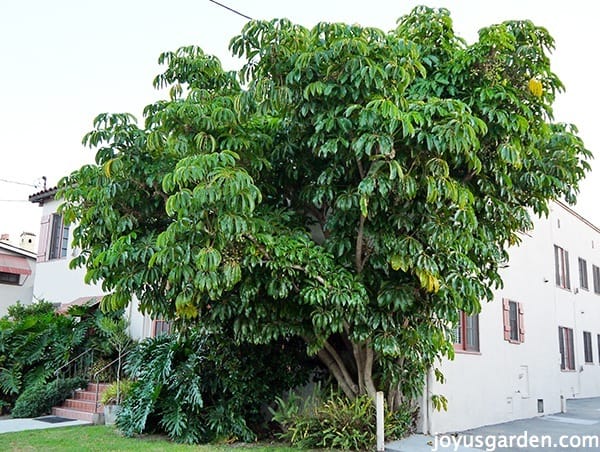
Here’s the Tupidanthus in the great outdoors here in Santa Barbara. A bit too vigorous for the average home!
Although Scheffleras love humidity, they are quite tolerant of the dry air our homes are notorious for having. The large glossy leaves, which resemble a hand with the fingers spread out, don’t seem to get as many brown tips as the leaves of other houseplants. Both indoors and outdoors, the Amates are great in containers.
See what I mean? These ginormous leaves make a statement.
We did a video for you about these tropical rainforest beauties which you’ll find at the end of this post. Here’s what you need to know about the Schefflera Amate before you buy one and also what you need to do to keep it going strong:
Size
As a houseplant, it generally stays smaller than 10′ tall. This is not a narrow plant so make sure you have the space for it.
Light
Medium. Amates like it nice & bright but no direct, burning sun. They actually tolerate a lower light level than their predecessors the Tupidanthus’. Give them a spin every now & then because like all plants, they grow towards the light.
Watering
Also, like the majority of houseplants, average. They need well-drained soil & their leaves will turn black if overwatered & kept soaking wet. A good drink every 10-14 days should do it. I’m going to do a video & blog post soon about watering houseplants so stay tuned.
Fertilizer
I give most of my houseplants a light application of worm compost with a light layer of compost over that every spring. Easy does it – 1/4 to 1/2? layer of each for a larger sized houseplant. Read about my worm compost/compost feeding right here.
The Amate in the grower’s greenhouse. The leaves will be cleaned off with water to shine them up before being sent out into the world.
Pruning
You can tip prune it twice a year to keep it size in check as it grows. Schefflera Amates can also be pruned hard if need be.
Propagation
By tip cuttings (the green stems) or by air layering.
Pests
Scale, mealy bug & spider mite. The Amates have been bred to be most resistant to mite.
I really like these plants and fortunately for you, they’re pretty easy to find. To learn more about Schefflera Amates and other fabulous houseplants, be sure to check out our book, Keep Your Houseplants Alive. This one will really give your home a tropical rainforest, jungle feel – look out for swinging monkeys!
A hole was cut in the roof so this Schefflera (Tupidanthus) has room to grow. Actually, which came 1st, the plant or the building?
A Schefflera hedge which is not looking its best due to our drought.
Here’s the video shot in a commercial greenhouse:
This post may contain affiliate links, you can read our policies here.
- About the Author
- Latest Posts
Nell, the founder of Joy Us garden, was born into a gardening family and grew up in Connecticut’s countryside. After living in Boston, New York, San Francisco, & Santa Barbara, she now calls the Arizona desert home. She studied horticulture & garden design, working in the field all her life. Nell is a gardener, designer, blogger, Youtube creator, & author. She’s been gardening for a very long time & wants to share what she’s learned with you.
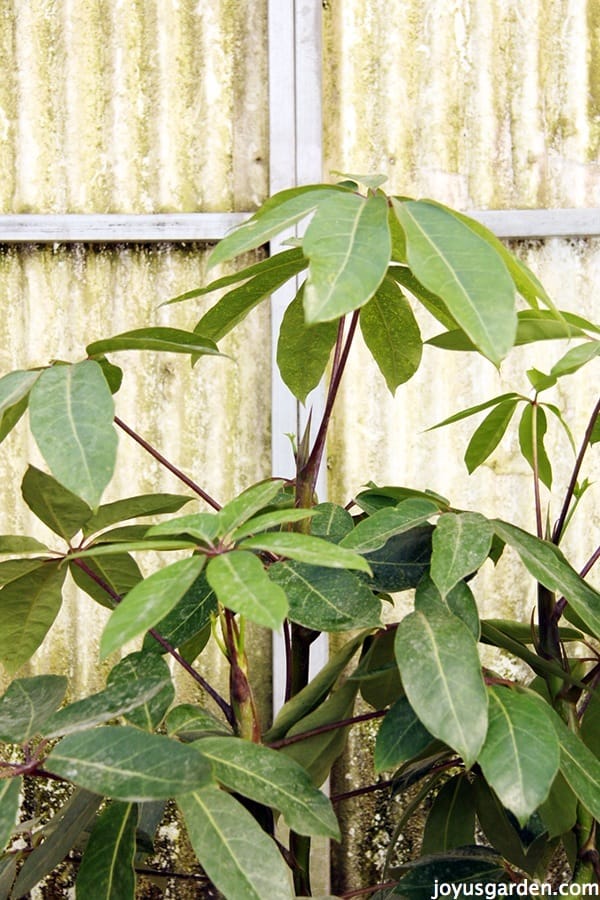
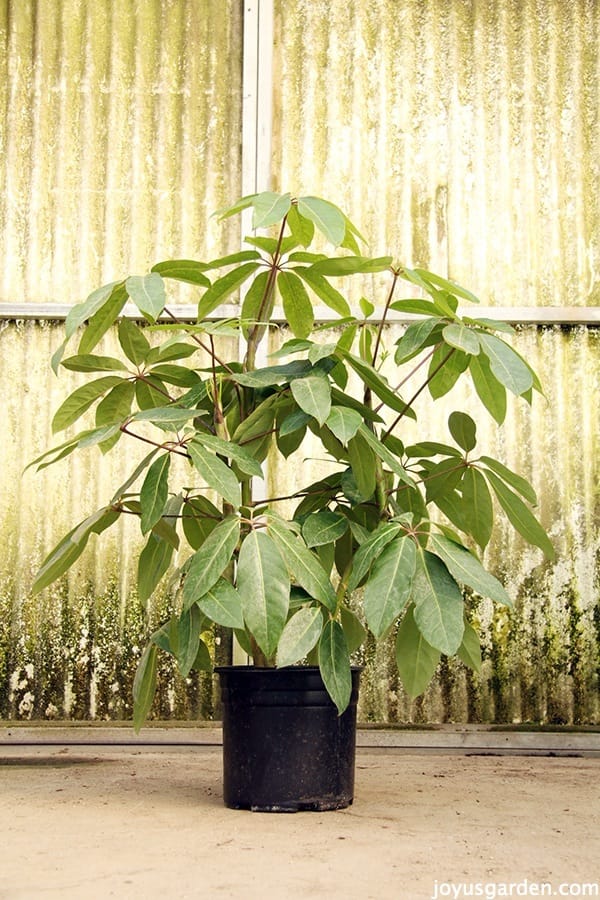
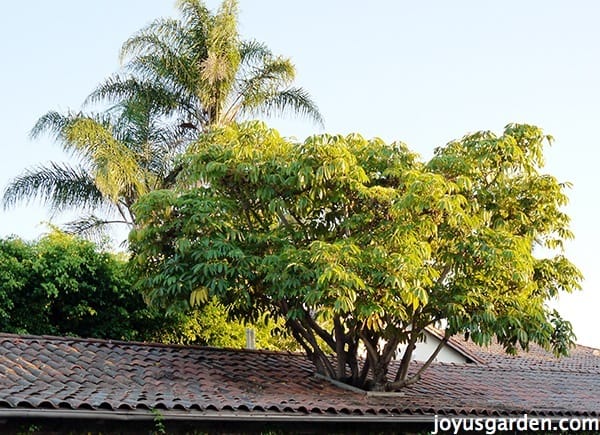
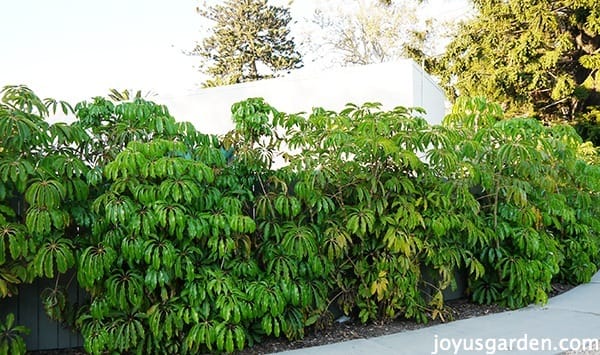
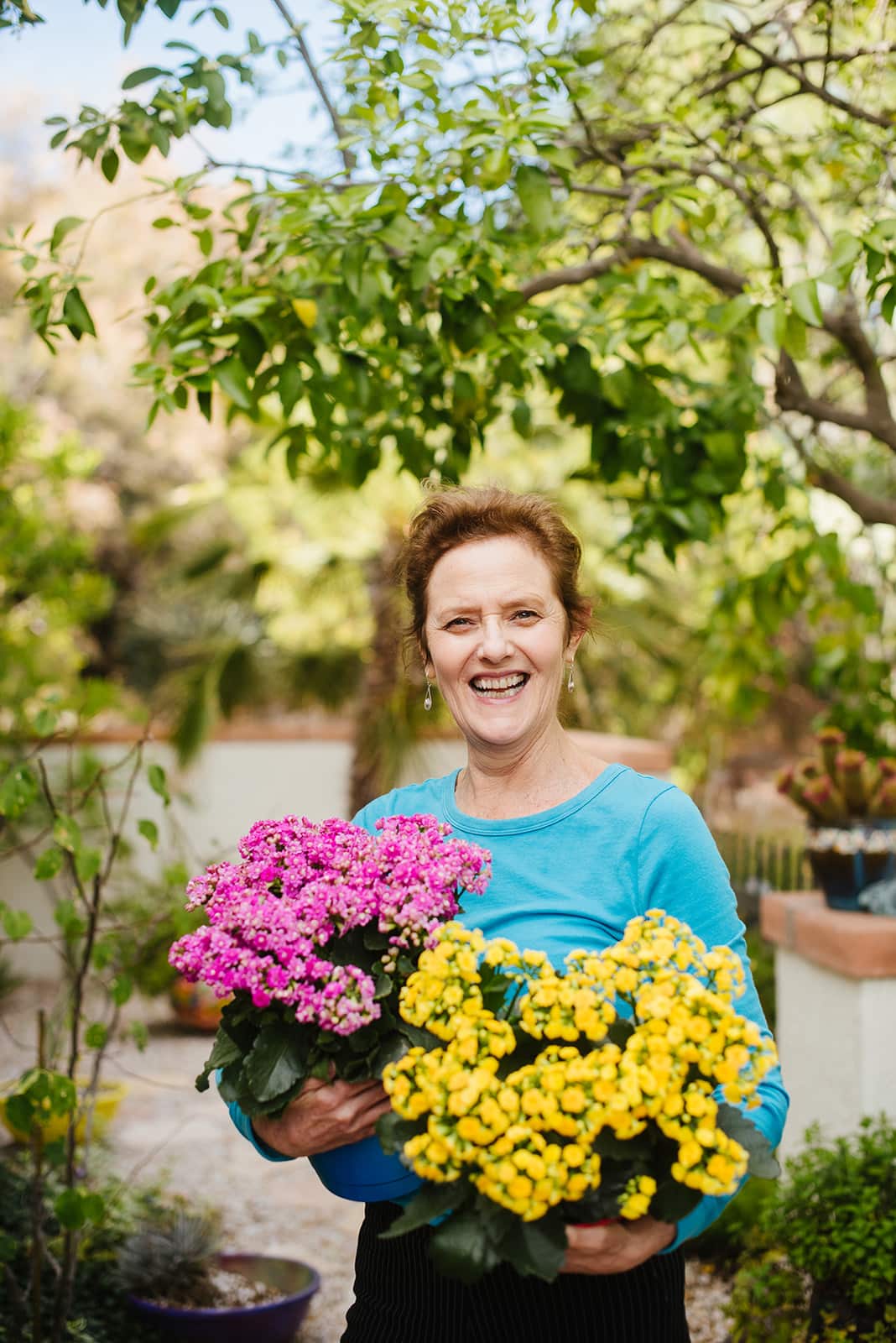
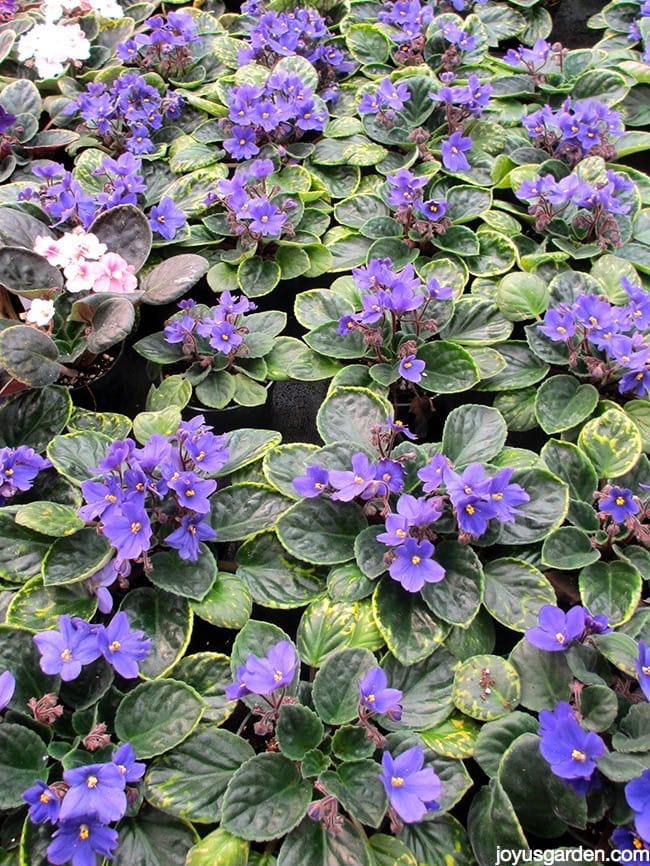

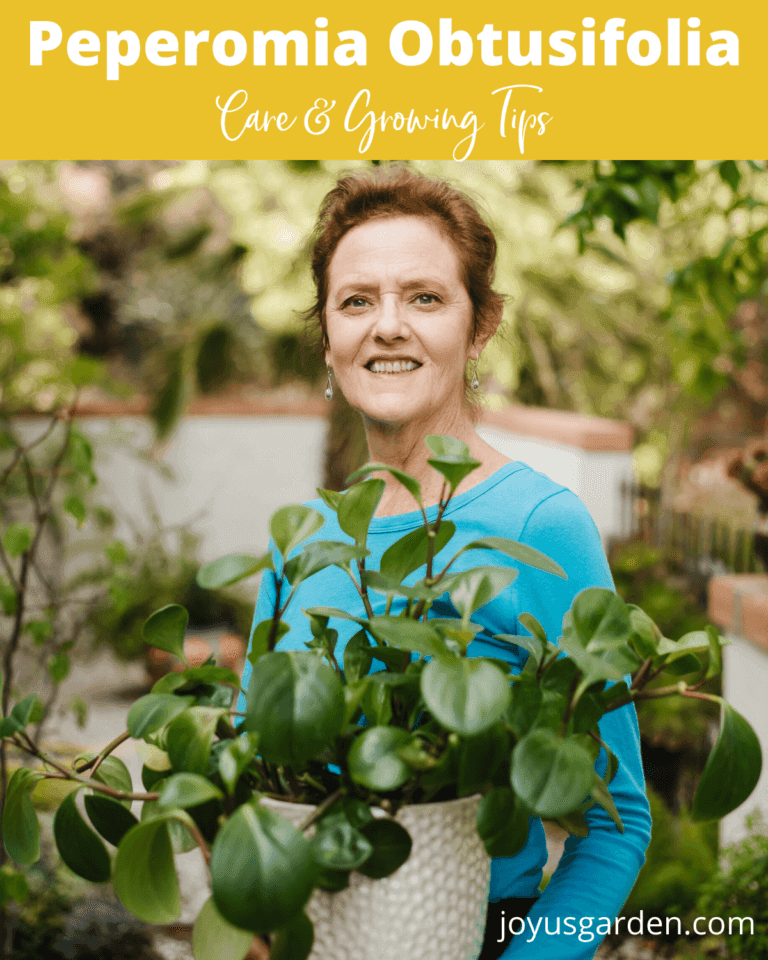
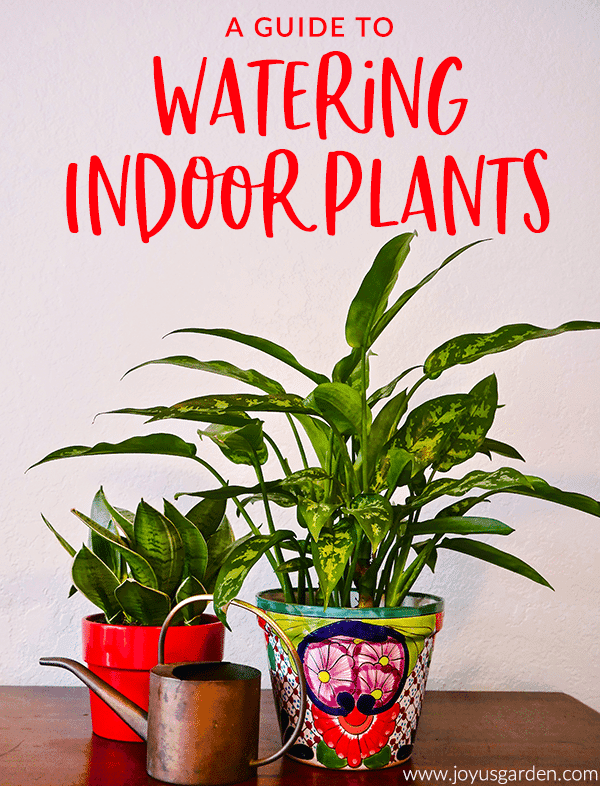

Hi Celeste – The Soleil is such a pretty Schefflera; I love the foliage on this one. Most houseplants cqn be a little slow to grow when you 1st bring them home. After all, they’ve been hanging out in a cozy greenhouse with all the conditions that they love. There are a couple of reasons which come to mind: it’s only been 3 months so it could just be going through adjustment as I just said or the light is too low. Plants rest in the winter & start to grow in spring – hence spring growth. You should see some action then! Nell
I have a 10-year-old Schefflera amate in a pot indoors by a window. All of the leaves droop down, none fan out. Do you have suggestions for what causes that? All are green and look healthy but the appearance is off with everything drooping.
Hi Scott – That’s common with all Scheffleras, not only the Amate. It can be due to a few reasons: too much water, too little water (although the leaves usually turn yellow 1st), &/or not enough light. Nell
I have a schefflera that was a few inches tell when my sister gave it to me in 1978. It is now about 7 feet tall. I have moved it many times over the years, but this last move was in December, and my plant is looking sad and not just because of the move. I have never pruned it, ever, because it was so gorgeous. But not so now. It has three stems, but they have no leaves for a few feet — one goes two feet without a leave; the second goes four feet before it has leaves, and the third’s first leaves at at five feet. How should I prune my dear plant? Its leave are still green and spotless, but a bit droopy.
Hi Mac – Scheffleras tend to get very leggy over time & benefit from a good pruning if that’s the case. You can cut the stems back to 6-12″ above the ground & new growth will eventually appear. It’s best to do this in spring or summer. Also, I like to cut the stems back at different heights so they don’t grow back like a blob. Rotate the plant as it’s growing so those stems get light all the way around. Nell
Thanks, Nell, for the good advice. Unfortunately, we can’t wait until spring for the pruning. As it is, the plant has nowhere to be where it is not terribly crunched and in the way, and we cannot get settled into our new home. I’ll let you know how it goes. Mac
Dear Nell
Thanks for the informative site.
I have a question about propagation:
Is it possible to root a tip cutting in a glass of water, like done with the dwarf Scheffleras?
Greetings from Denmark.
Greetings to you in Denmark from Arizona. I’m glad you’re finding the site helpful. I’m not 100% sure about th rooting in water because I’ve never done it. I’ve always propagated the larger scheff (what was Tupidanthus now Amate) by air layering when it was getting too tall. I know the tip cuttings root in mix but not sure about water. If you try it & have success, please let us know! Nell
Hi there!
How do I keep my plant well drained when I water it? I only just got it a couple of weeks ago and I’ve noticed a leaf has some black spots on it!!
Hi Megan – The soil mix need to be well drained – a heavy mix doesn’t drain well. Often times the mix a plant comes in is too wet & takes too long to dry out. Make sure the pot has at lease 1 drainage hole. Nell